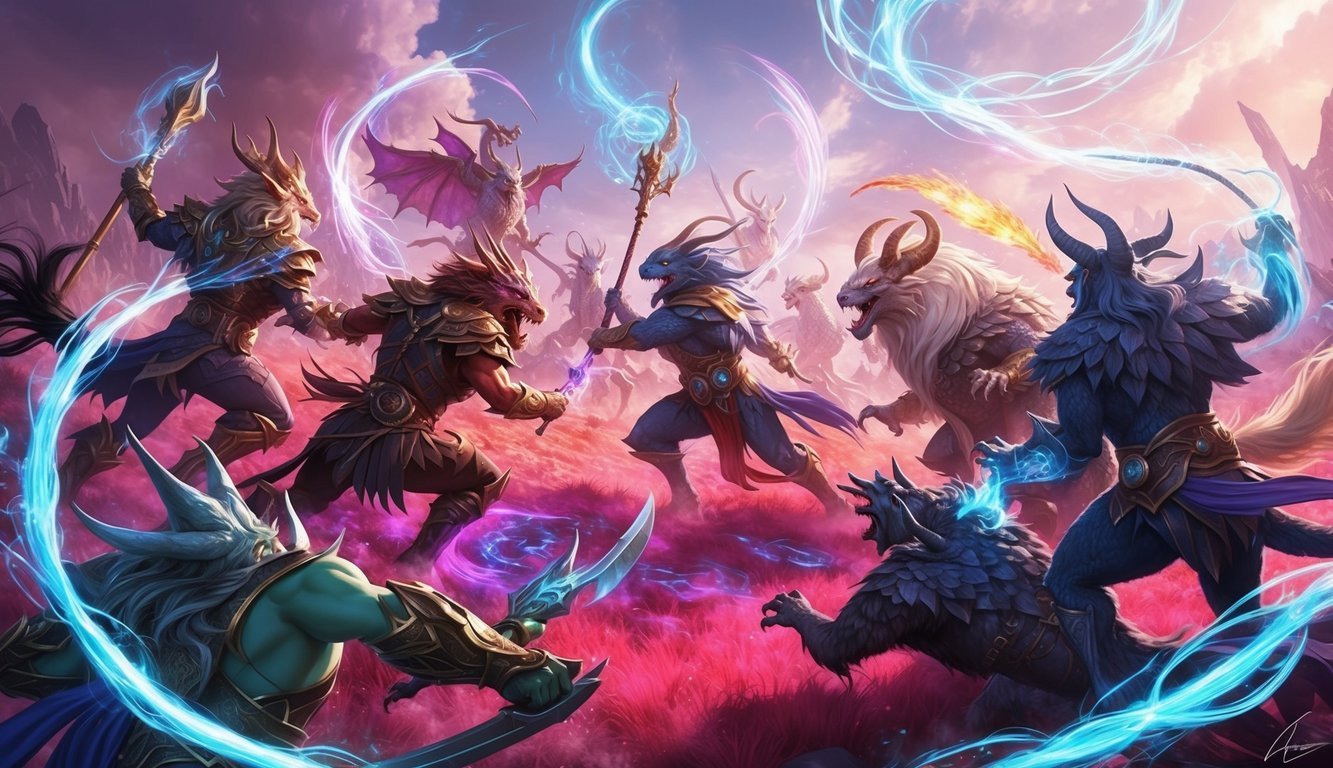Collectible Card Games have taken the gaming world by storm, offering a unique blend of strategy, luck, and the thrill of building your own deck.
From Magic: The Gathering to Pokémon, these games have captivated players for decades. CCGs allow you to customize your playstyle, collect rare cards, and engage in epic battles with friends or opponents worldwide.
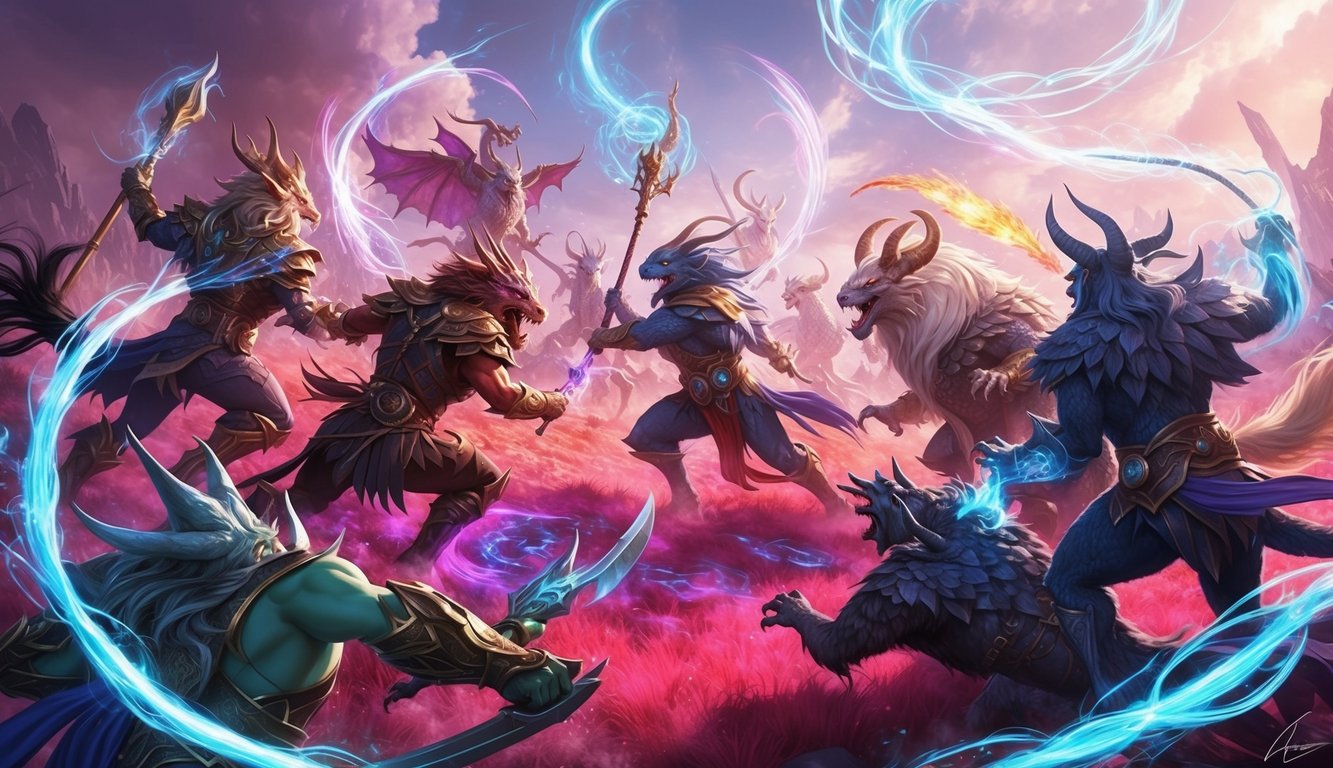
You’ll find a wide variety of themes and mechanics across different CCGs.
Some transport you to fantasy realms filled with mythical creatures, while others let you command futuristic armies or duel with your favorite anime characters.
The beauty of these games lies in their endless possibilities – each match is a new adventure waiting to unfold.
Whether you’re a seasoned player or new to the scene, CCGs offer something for everyone.
You can start with pre-built decks to learn the ropes, then gradually expand your collection and craft powerful strategies.
With online platforms making these games more accessible than ever, there’s never been a better time to dive into the exciting world of Collectible Card Games.
History and Evolution of CCGs
Collectible card games have come a long way since their inception in the early 1990s.
You’ll be fascinated by how this genre grew from a single innovative game to a diverse ecosystem of beloved franchises.
Origins and the Rise of Magic: The Gathering
Magic: The Gathering burst onto the scene in 1993, revolutionizing tabletop gaming.
Created by mathematician Richard Garfield, it combined strategy, collectibility, and fantasy elements.
You could build custom decks, trade cards, and battle other players.
The game’s success was immediate.
Players were hooked on its depth and variety.
Magic’s popularity soared, inspiring tournaments and a competitive scene.
You might have seen game stores packed with enthusiasts during this boom.
As Magic grew, it paved the way for the entire CCG industry.
Its innovative mechanics and business model became the blueprint for future games.
Expansion and the Diversification of CCGs
Following Magic’s success, the CCG market exploded with new titles.
In 1996, you saw the release of Pokémon TCG, which capitalized on the franchise’s popularity.
It quickly became a cultural phenomenon, especially among younger players.
Yu-Gi-Oh! entered the scene in 1999, bringing anime-inspired artwork and fast-paced gameplay.
Its ties to the TV show helped it gain a massive following.
Legend of the Five Rings, launched in 1995, offered a unique setting based on feudal Japan.
It attracted players looking for rich lore and strategic depth.
As the market expanded, you found CCGs based on various themes:
- Sci-fi
- Sports
- Historical events
- Popular media franchises
This diversification allowed you to find a game that matched your interests and playstyle.
Understanding the Basics of CCGs
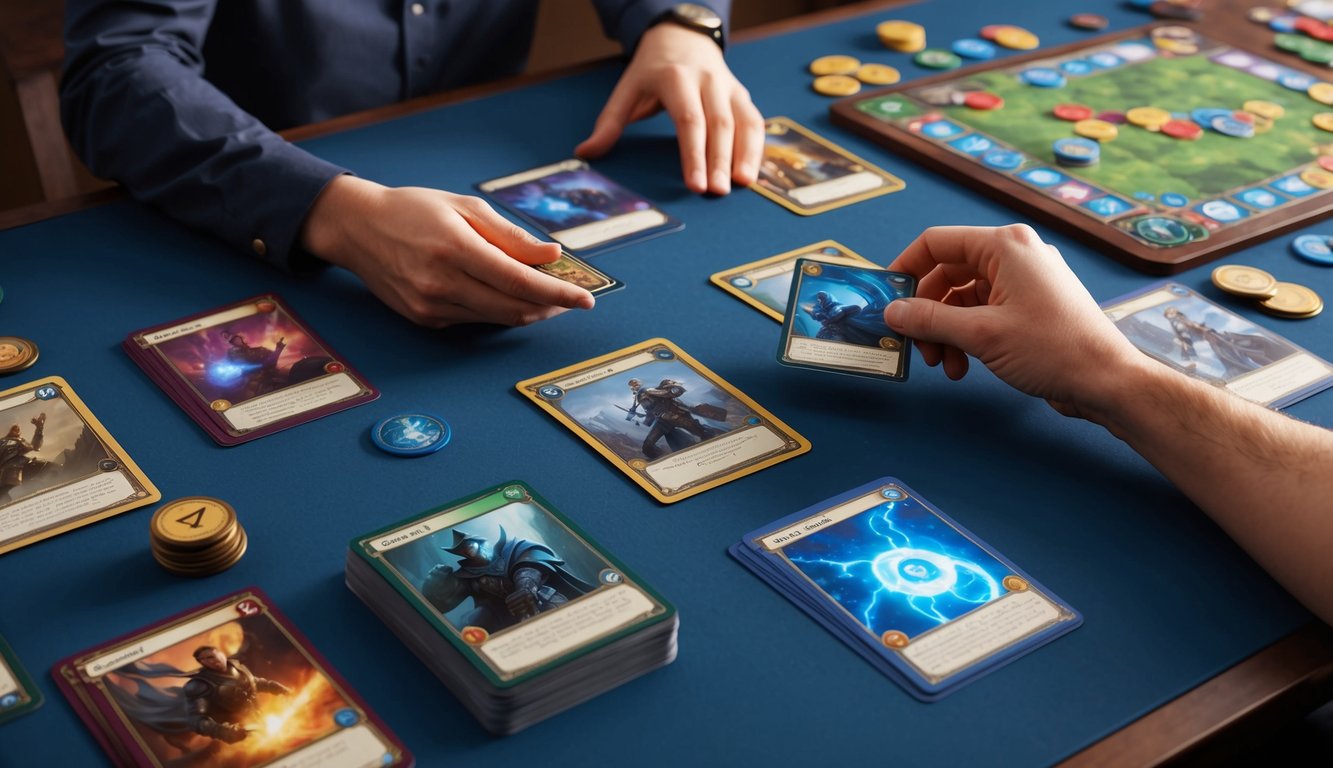
Collectible Card Games (CCGs) combine strategy, luck, and collectibility into an engaging hobby.
You’ll encounter unique terminology, discover the thrill of opening booster packs, and learn the art of deck building as you dive into this exciting world.
Core Concepts and Terminology
CCGs revolve around battling opponents using custom-built decks.
You’ll need to familiarize yourself with common terms like “mana” for resources, “creatures” for battle units, and “spells” for special effects.
Each game has its own unique vocabulary, but these concepts are often similar across different CCGs.
Card types typically include:
- Creatures or characters
- Spells or actions
- Resources or energy
- Equipment or artifacts
Understanding card rarities is crucial.
Common cards are plentiful, while rare and mythic rare cards are harder to find but often more powerful.
The Role of Booster Packs
Booster packs are the lifeblood of CCGs.
These sealed packages contain a random assortment of cards, usually including a mix of common, uncommon, and rare cards.
Opening boosters is exciting – you never know what you might get!
Key points about booster packs:
- They’re used to expand your collection
- Prices vary but typically range from $3 to $5
- Special sets may have themed boosters
- Some packs guarantee a rare or foil card
Booster drafts are popular events where players open packs and build decks on the spot, adding another layer of strategy to the game.
Deck Building Explained
Deck building is where your creativity shines in CCGs.
You’ll construct a deck from your card collection, following specific rules for each game.
Most games require a minimum deck size, often around 60 cards.
Tips for effective deck building:
- Choose a strategy or theme
- Balance your card types
- Include enough resource cards
- Consider your “mana curve” for smooth play
- Don’t forget about synergies between cards
Playtesting is crucial.
You’ll refine your deck through trial and error, adjusting card choices based on performance.
Remember, there’s no perfect deck – the meta constantly evolves as new cards are released and strategies develop.
Gameplay Mechanics
Collectible card games feature unique gameplay mechanics that set them apart from other card games.
These mechanics create strategic depth and replayability, keeping players engaged for years.
Turn Structure and Flow of Play
In most CCGs, you and your opponent take alternating turns.
Your turn typically consists of several phases:
- Draw phase: Draw a card from your deck.
- Main phase: Play cards, activate abilities, and attack.
- End phase: Discard excess cards and resolve end-of-turn effects.
Some games have additional phases, like an upkeep phase or a combat phase.
The specific order and actions allowed in each phase vary between games, but this structure creates a rhythm to the gameplay.
Resource Systems and Management
CCGs often use resource systems to control the pace of the game.
Common resource types include:
- Mana (Magic: The Gathering)
- Energy (Pokémon TCG)
- Life Points (Yu-Gi-Oh!)
You’ll need to manage these resources carefully.
Some games require you to play specific cards to generate resources, while others grant a set amount each turn.
Balancing resource use with card play is a key strategic element.
Strategies and Tactics
CCGs offer a wide range of strategies and tactics.
You’ll need to consider:
- Deck composition: Building a cohesive deck with synergistic cards
- Card advantage: Drawing more cards than your opponent
- Tempo: Controlling the pace of the game
- Board control: Maintaining a stronger presence on the playing field
Your strategy might focus on aggressive early-game plays, building up resources for powerful late-game cards, or disrupting your opponent’s plans.
Adapting your tactics based on your opponent’s moves is crucial for success.
Popular CCGs and Their Communities
Collectible card games have captivated players worldwide, fostering vibrant communities and competitive scenes. Magic: The Gathering, Pokémon TCG, and Yu-Gi-Oh! stand out as industry titans with massive player bases.
Spotlight on Top CCGs
Magic: The Gathering reigns supreme in the CCG world.
Its intricate gameplay and rich lore have kept fans hooked since 1993.
You’ll find a diverse range of players, from casual kitchen table groups to pro tour champions.
Pokémon TCG capitalizes on the beloved franchise, attracting both kids and adults.
Its colorful artwork and familiar characters make it accessible to newcomers.
Yu-Gi-Oh! boasts a dedicated following, especially among anime fans.
The game’s fast-paced duels and ever-evolving meta keep players on their toes.
Evolving Player Bases and Fan Cultures
CCG communities are constantly shifting.
You’ll notice Magic: The Gathering Arena has brought in a new wave of digital players, bridging the gap between paper and online play.
Fan cultures develop unique identities.
Pokémon TCG enthusiasts often blend their love for the cards with video game and anime fandom.
Online forums and social media groups have become hubs for strategy discussions, deck-building tips, and card previews.
You can easily connect with fellow players worldwide.
Competitive Scene and Tournaments
The CCG tournament scene is thriving.
Major events like Magic: The Gathering’s Pro Tour and the Pokémon World Championships draw players from across the globe.
Local game stores host regular tournaments, giving you a chance to test your skills.
These grassroots events are the lifeblood of CCG communities.
Prize pools for top-tier tournaments can reach impressive sums.
Yu-Gi-Oh! Championship Series events offer substantial cash prizes and exclusive cards to winners.
Streaming platforms have given competitive play a broader audience.
You can watch expert players showcase their skills and learn new strategies in real-time.
Digital vs. Physical CCGs
Collectible card games have evolved beyond the tabletop, offering digital alternatives that bring both advantages and drawbacks.
The rise of digital platforms has changed how players collect, trade, and battle with their cards.
Benefits of Digital CCGs
Digital CCGs like Magic: The Gathering Arena offer convenience at your fingertips.
You can play anytime, anywhere, without lugging around heavy card collections.
Matchmaking is quick and easy, connecting you with opponents of similar skill levels.
Digital games handle rule enforcement automatically, eliminating disputes and ensuring smooth gameplay.
Card management is a breeze in digital CCGs.
Your collection is always organized, and you’ll never misplace a rare card.
Updates and new expansions are instantly available, keeping the game fresh.
Many digital CCGs also offer free-to-play options, letting you build your collection gradually without a large upfront cost.
Charm of Physical Card Games
Physical CCGs have a tactile appeal that digital versions can’t replicate.
There’s something special about shuffling a deck, feeling the weight of your cards, and seeing them spread across the table.
Collecting physical cards gives you tangible objects to cherish and display.
Trading cards face-to-face adds a social element that’s hard to match digitally.
You can swap stories, admire each other’s collections, and haggle over trades.
Card sleeves protect your prized possessions while adding a personal touch to your deck.
Physical tournaments create a unique atmosphere, bringing players together in person.
The excitement of opening a new pack and the thrill of pulling a rare card are experiences that digital CCGs struggle to replicate.
Hybrid Game Models
Some CCGs are bridging the gap between digital and physical play.
These hybrid models let you scan physical cards to use them in digital games.
You can enjoy the best of both worlds – the tactile experience of physical cards and the convenience of digital play.
Hybrid models often allow you to redeem codes from physical products for digital rewards.
This approach encourages players to engage with both versions of the game.
Some games even let you print custom cards at home, blending digital design with physical gameplay.
These innovative approaches are reshaping how players interact with CCGs, offering flexibility and new ways to enjoy your favorite games.
Collecting and Investing in CCGs
Collecting and investing in Collectible Card Games can be both a thrilling hobby and a potentially lucrative venture.
You’ll discover the joy of hunting for rare cards and the excitement of watching your collection grow in value over time.
The Collectible Aspect
CCGs have a collectible nature at their heart.
When you open booster packs, you get a rush of excitement.
You hope to find that elusive rare card.
Building your collection becomes a game in itself.
You might focus on completing specific sets or chasing after unique cards that catch your eye.
Trading with other collectors adds a social element to the hobby.
You’ll meet like-minded enthusiasts at local game stores or online forums.
These connections can lead to friendships and valuable trading opportunities.
Some collectors aim for a complete set of every card in a game.
Others prefer to collect only their favorite characters or artwork.
There’s no right or wrong way to collect – it’s all about what brings you joy.
Rarity, Value, and Market Trends
The value of trading cards can fluctuate wildly based on rarity and demand.
You’ll want to keep an eye on market trends to make informed decisions about buying and selling.
Rarity tiers typically include:
- Common
- Uncommon
- Rare
- Ultra Rare
- Secret Rare
Cards from older sets or with limited print runs often command higher prices.
Competitive play can also drive up values, as players seek out powerful cards for their decks.
Condition matters greatly in the CCG market.
Near-mint or mint condition cards fetch the highest prices.
You’ll want to store your valuable cards in protective sleeves and cases to maintain their condition.
Online marketplaces and price guides can help you track card values.
Just remember, the CCG market can be volatile.
A card’s value might spike due to a new strategy or nostalgia, only to drop later.
Art and Design in CCGs
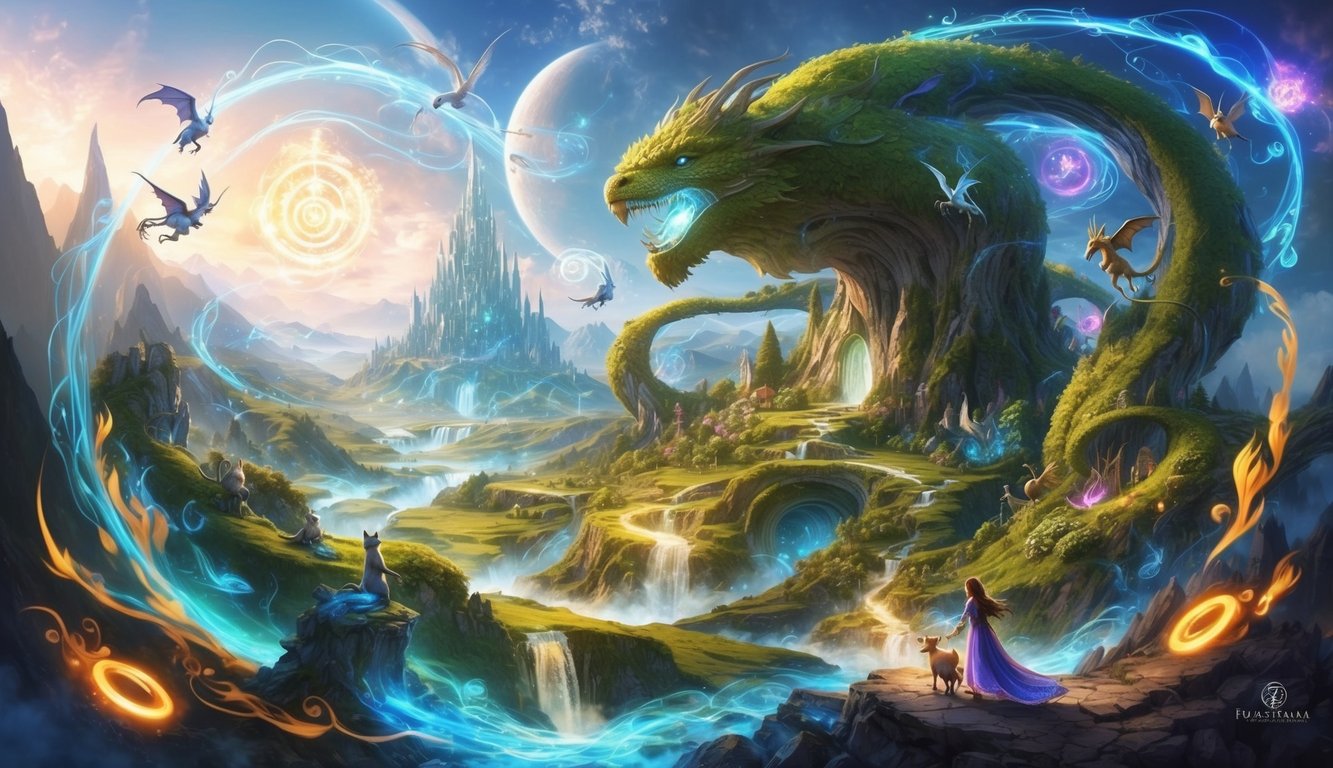
Collectible card games dazzle players with stunning visuals and innovative designs.
The artwork and card layouts are crucial elements that bring the game world to life and enhance the overall playing experience.
Visual Appeal and Artwork
CCGs are packed with eye-catching illustrations that transport you to fantastical realms.
Each card showcases unique characters, creatures, or scenes that spark your imagination.
Artists pour their creativity into crafting these miniature masterpieces, often using digital painting techniques or traditional mediums.
Some games feature a consistent art style, while others embrace diverse artistic approaches.
You might encounter realistic portraits, stylized anime-inspired drawings, or abstract compositions.
The artwork not only looks great but also helps you quickly identify cards during gameplay.
Many players collect cards solely for their artistic merit, displaying favorites or rare pieces in binders or frames.
Card Design and Aesthetics
CCG designers carefully craft card layouts to balance visual appeal with functionality.
You’ll notice how text, symbols, and artwork are arranged to convey information at a glance.
The card frame, background textures, and typography all contribute to the game’s unique aesthetic.
Some games use foil treatments, holographic effects, or textured finishes to make cards feel special.
These enhancements add a tactile dimension to your collection and make rare cards stand out.
Designers also consider how cards look when laid out on the table.
You’ll appreciate how colors and patterns help you quickly sort and organize your deck during play.
Community and Social Engagement
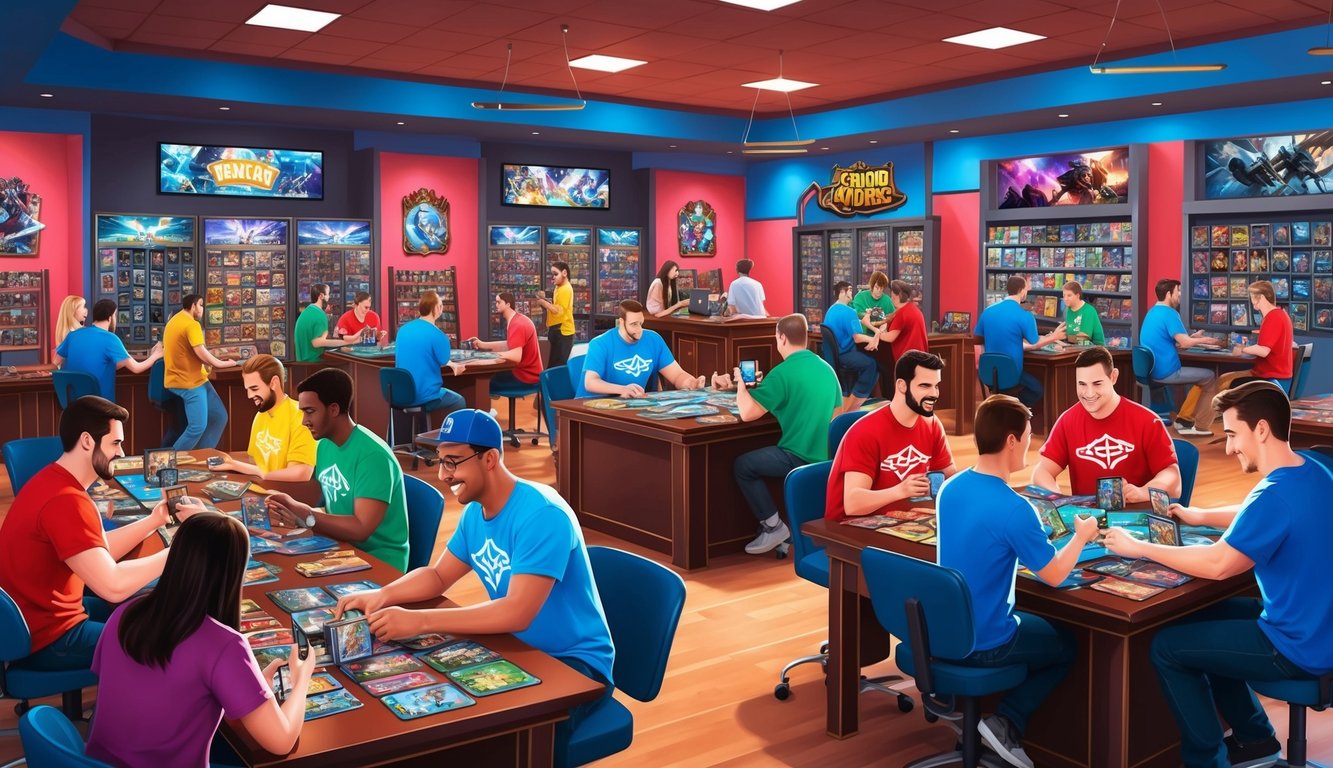
CCGs bring people together through shared passion and friendly competition.
You’ll find vibrant communities both locally and online where players connect, trade cards, and improve their skills.
Building a Local Playgroup
Looking to start a CCG group in your area? Begin by reaching out to local game shops.
They often host weekly tournaments or casual play nights.
You can also post flyers at community centers or schools to attract interested players.
Once you’ve gathered a few people, set up regular meetups.
Choose a consistent time and place, like a coffee shop or library meeting room.
Bring extra decks for newcomers to try out.
Encourage a welcoming atmosphere where both beginners and experts can enjoy playing together.
Consider organizing small tournaments with fun prizes to keep things exciting.
As your group grows, you might even start a league or host larger events.
Online Communities and Forums
The internet opens up a whole new world of CCG connections.
Join online forums dedicated to your favorite games.
You’ll find strategy discussions, deck-building advice, and trading opportunities.
Many CCGs have official Discord servers where you can chat with players worldwide.
Participate in online tournaments to test your skills against a diverse player base.
Watch live streams and gameplay videos to learn new tactics.
Social media groups are great for staying updated on game news and connecting with local players.
Share your rare card pulls or tournament wins to celebrate with fellow enthusiasts.
Exploring Different CCG Genres
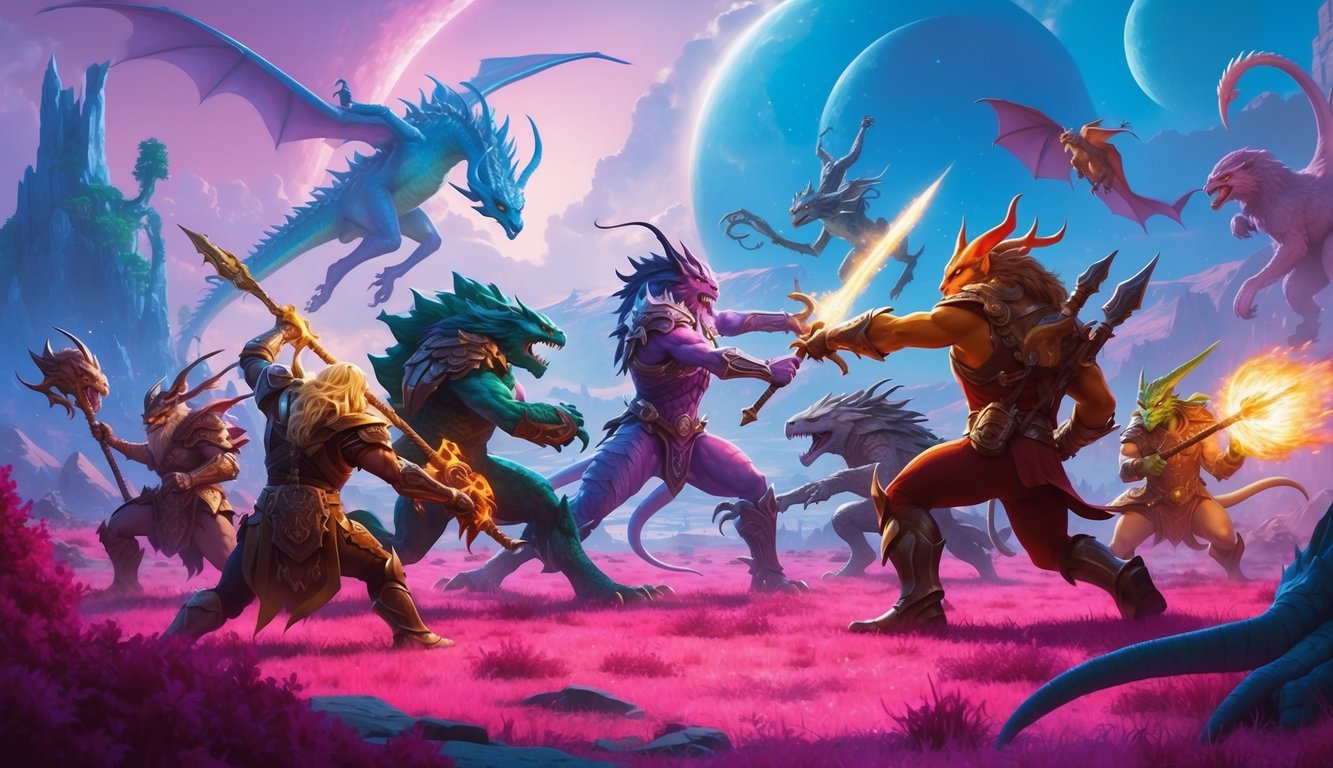
Collectible card games span a wide range of genres, each offering unique themes and gameplay mechanics.
Let’s explore some of the most popular and innovative categories in the CCG world.
Fantasy and Sci-Fi CCGs
Fantasy and sci-fi themes dominate many CCGs, transporting you to magical realms and distant galaxies.
Magic: The Gathering remains the granddaddy of fantasy CCGs, with its rich lore and complex spell-slinging battles.
For sci-fi enthusiasts, Star Wars: Destiny offers fast-paced dice and card action set in the iconic galaxy far, far away.
You’ll build decks around your favorite characters and vehicles, rolling dice to determine the outcome of epic confrontations.
Warhammer Age of Sigmar: Champions brings the grim darkness of Games Workshop’s fantasy universe to the CCG format.
You’ll command mighty heroes and unleash devastating spells in your quest for supremacy.
Anime and Pop Culture CCGs
Anime-inspired CCGs have exploded in popularity, with Yu-Gi-Oh! leading the charge.
You’ll summon powerful monsters, cast spells, and set traps in high-stakes duels.
The game’s ever-evolving mechanics and ties to the anime series keep it fresh and exciting.
Disney Lorcana is a newer entry in the pop culture CCG space.
You’ll build decks around beloved Disney characters, each with unique abilities that reflect their personalities and stories.
The game’s gorgeous artwork and family-friendly gameplay make it accessible to fans of all ages.
Pokémon TCG continues to captivate players with its adorable creatures and strategic battles.
You’ll collect your favorite Pokémon and pit them against your opponents in turn-based matches.
Innovative and Niche CCGs
Some CCGs push the boundaries of the genre with unique mechanics and themes.
Keyforge, for example, features algorithmically generated decks, ensuring that no two players have the same card combinations.
Flesh and Blood takes a different approach to resource management, with heroes using their health as a resource to power devastating attacks.
This creates tense, back-and-forth battles where every decision counts.
For history buffs, Anachronism lets you pit historical figures from different eras against each other in strategic combat.
You might see Genghis Khan facing off against Joan of Arc in a battle of wits and strength.
Future Trends in CCGs
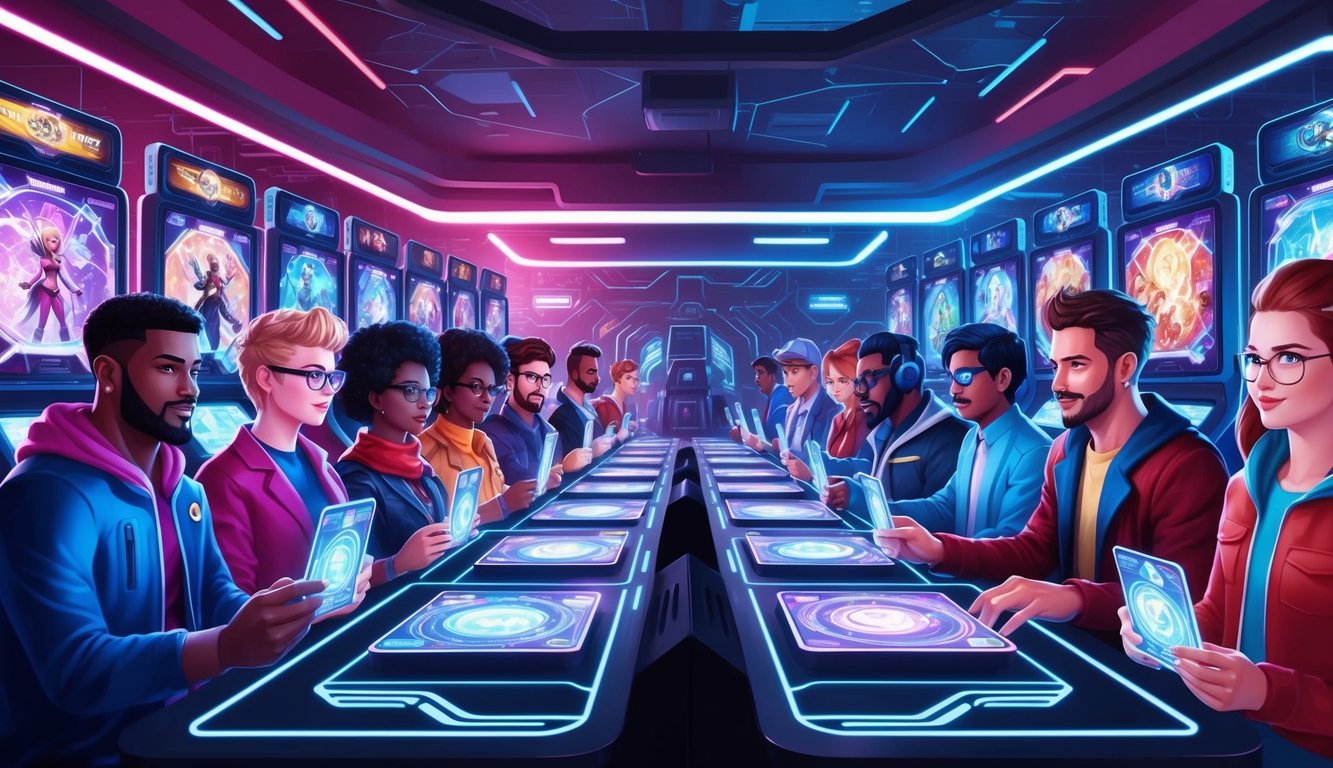
Exciting changes are coming to collectible card games.
New innovations and technology will reshape how you play and collect cards in the years ahead.
Emerging Games and Innovations
Keep an eye out for fresh CCG titles hitting the scene.
Games like Eternal and Slay the Spire are shaking things up with unique mechanics and gameplay styles.
You’ll see more CCGs blending genres, like roguelike elements or deck-building with RPG progression.
Digital-only games will continue pushing boundaries.
They can update cards on the fly and introduce wild effects not possible in physical games.
Expect to see CCGs experimenting with things like live events, co-op modes, and card evolution systems.
Technology’s Impact on CCG Development
Augmented reality is set to transform how you interact with cards.
Imagine seeing your creatures come to life on the table or watching epic battles unfold in 3D.
AR will add a whole new layer of immersion to collecting and playing.
Digital platforms will make CCGs more accessible than ever.
Games like Gwent show how free-to-play models can attract huge player bases.
You’ll have more ways to play on the go with improved mobile versions of popular CCGs.
Online marketplaces will continue revolutionizing card trading and collecting.
It’s now easier than ever to buy, sell, and trade cards globally.
This digital shift is fueling the collectibility aspect of CCGs in exciting new ways.

